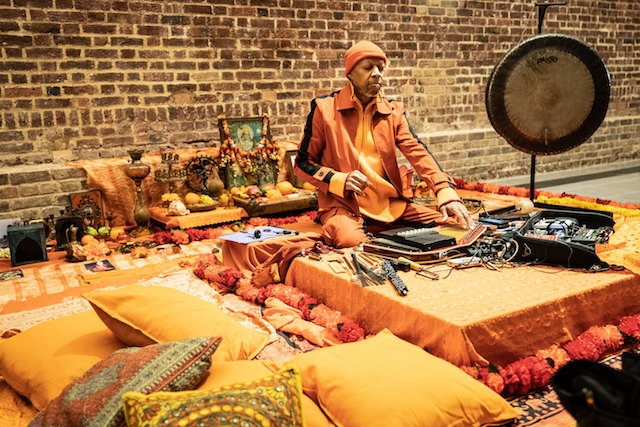The first exhibition I visited in 2019 – Grace Wales Bonner’s A Time for New Dreams at the Serpentine Galleries – exemplified the spirit of cross-pollination that has seen performance and dance, experimental literature, fashion and club culture staged in London’s museums and galleries over the past year. The British-Jamaican fashion designer’s presentation of shrinelike installations, sculptures, photography and video – by artists including Kapwani Kiwanga, David Hammons, Liz Johnson Artur and Eric N. Mack – explored spirituality and mysticism in black culture. Live events varied from deep-listening sessions and gong ceremonies by the meditation practitioner Laraaji to dance performances and poetry readings, with the closing weekend culminating in the presentation of Wales Bonner’s AW19 collection.
The Serpentine exhibition is symptomatic of the ways in which London’s cultural production is becoming more fluid and multihyphenate: designer-as-curator, artist-as-designer and so on. This was also pronounced in the South London Gallery’s summer exhibition dedicated to Susan Cianciolo, an artist who has wilfully evaded the distinctions between fashion, art and craft throughout her career. Cianciolo’s repurposing of her own ephemeral archive in order to create new work, often intricate and talismanic assemblages of clothing, textiles, notes and sketches, signifies a resurgence of interest in lo-fi or emphatically handmade works. Fabric and material objects, particularly when framed within the context of the body, become a means to explore identity, selfhood and desire. Tenant of Culture (aka Hendrickje Schimmel), whose sculptures Eclogues (an apology for actors) (2019) were shown at Nicoletti Contemporary in the autumn, also utilises found and discarded materials in her work. Bulky plaster busts were dressed in bonnets, ruffs and blouses in the style of milkmaids. Made from recycled garments and accessories, they were adorned with ribbons, loose threads, deconstructed wig pieces and tendrils of human hair. Made in response to the current nostalgia for a pastoral idyll in contemporary fashion, Schimmel’s exhibition explored the hypocrisy latent in the classes calling for a ‘return to a nature’ being those who also control the means of production.
London’s cultural production is becoming more fluid and multihyphenate: designer-as-curator, artist-as-designer…
The relationship between experimental art and literature was explored in the presentation of Antonin Artaud’s notebooks and drawings – Cahiers de Rodez et d’Ivry 1945–1948 – at Cabinet Gallery in the spring, and in the summer at the ICA’s I, I, I, I, I, I, I, Kathy Acker. The latter focused on Acker’s legacy, situating archival material alongside work by Jamie Crewe, Penny Goring, VNS Matrix, Nancy Spero and others, in addition to programming lectures, panel discussions, theatrical productions, reading groups and film screenings. Rather than positioning Acker as a one-size-fits-all forerunner, this sprawling exhibition showed how the cultural space can become a meeting point for the different economies of art, performance and publishing. That a public programme should be integrated into a show’s curatorial framework had already been set forth by Beatrice Gibson’s exhibition at Camden Arts Centre, which opened in late January. Alongside two interconnected films, Gibson’s ‘expanded cinema’ led to the development of a live pro- gramme in collaboration with poets Eileen Myles and CAConrad, encompassing readings, writing workshops and somatic rituals.
The title of Gibson’s show, Crone Music, was taken from the 1990 album by Pauline Oliveros. The composer’s ability to work across the realms of electronic music and art was summoned when watching Pan Daijing’s play Tissues (2019), which premiered at Tate Modern in the autumn. Tissues was performed in the Tanks by three opera singers and ten performers and set to a dronelike industrial sound-scape that oscillated cinematically between haunting melancholy and rousing, cathartic noise. Earlier in the year, Anne Imhof’s durational four-hour work Sex had ricocheted through that same subterranean space, blending choreography, tableau vivant and music in her fashionable (albeit divisive) version of Tanztheater, where the temporality, ebbing and flowing, echoed the circadian rhythm of a nightclub. The pleasure and politics of club culture was another leitmotif this year, with the Barbican’s autumn show considering the artistic role of cabaret and clubs, and Mark Leckey’s Fiorucci Made Me Hardcore (1999) gracing the halls of Tate Britain, 20 years after its original release. Both Kiss My Genders at the Hayward Gallery – a large-scale survey exhibition, with over 100 works made by 30 international artists who identify across the gender spectrum – and Louise O’Kelly’s programming of DRAF’s annual Evening of Performances at Ministry of Sound considered the importance of nightlife as a radical and uncensored space, alluding to the troubling closure of numerous venues in the city. The closure of LGBTQ+ venues was addressed by The Whitechapel Gallery’s Queer Spaces: London, 1980s – Today, which opened in April. The research-led archival presentation also avoided any vain attempt to translate the hedonistic nightclub experience into an environment as self- conscious as the gallery. As a part of a wider institutional drive to revise the art historical canon, a number of previously underrepresented artists received their first or long overdue museum shows in the capital: Frank Bowling and Dorothea Tanning at Tate; Faith Ringgold and Luchita Hurtado at the Serpentine; Lee Krasner at the Barbican; the Chicago Imagists at Goldsmiths CCA; Helene Schjereck at the Royal Academy, to name a few. The appetite for figurative representation has also been sustained, with female painters interrogating and subverting the history of the medium. These range from Lisa Brice’s smoking nudes at Stephen Friedman Gallery in the autumn, to the work of Tschabalala Self, Lynette Yiadom-Boakye and Njideka Akunyili Crosby, brought together by Isaac Julien in his group show of ‘aesthetic reparations’ at Victoria Miro. At an unstable time in London, the impulse to disrupt feels like the only constant.
This article originally appeared in the November 2019 issue of ArtReview
